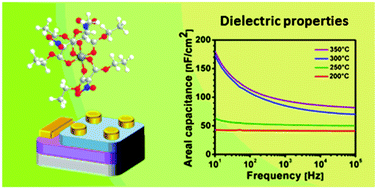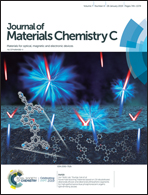Synthesis, dielectric properties and application in a thin film transistor device of amorphous aluminum oxide AlxOy using a molecular based precursor route†
Abstract
Amorphous aluminium oxide thin films are accessible by a molecular single source precursor approach employing the coordination compound tris[(diethyl-2-nitromalonato)]aluminium(III) (Al-DEM-NO2). The precursor decomposes by thermal combustion under oxygen without the need of an additional additive into amorphous aluminium oxide films at 350 °C with a very low surface roughness of about 0.3 nm. Solution processing of the precursor results in the formation of smooth, dense and crack-free films, which are converted into amorphous AlxOy thin films after further calcination. Amorphous AlxOy thin films integrated within a capacitor device exhibit dielectric behavior in the temperature range between 200 and 350 °C, with areal capacity values between 41 and 86 nF cm−2 and leakage current densities ranging from 1.7 × 10−7 to 8.9 × 10−10 A cm−2 (at 1 MV cm−1) whereas breakdown voltages increase from 1.82 to 2.79 MV cm−1 in the temperature regime from 200 to 350 °C. The increase in performance at higher temperatures can be attributed to the stepwise conversion of the intermediate aluminium oxo–hydroxy species into aluminium oxide which is confirmed by X-ray photoelectron spectroscopy (XPS).



 Please wait while we load your content...
Please wait while we load your content...